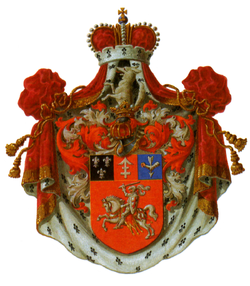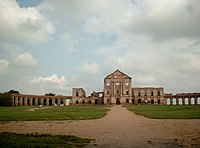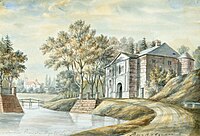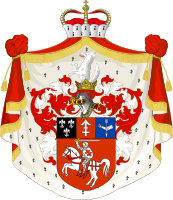| Revision as of 12:57, 21 June 2013 editYobot (talk | contribs)Bots4,733,870 editsm WP:CHECKWIKI error #2 fix + general fixes using AWB (9276)← Previous edit | Revision as of 23:23, 6 July 2013 edit undoSobiepan (talk | contribs)3,090 editsmNo edit summaryNext edit → | ||
| Line 27: | Line 27: | ||
| The creator of the fortune and power of the Sapieha family was the Court and Great ] and Great ] of Lithuania ]. | The creator of the fortune and power of the Sapieha family was the Court and Great ] and Great ] of Lithuania ]. | ||
| On 14 September 1700, ] obtained the title of ] from Emperor ]. The title became extinct upon his death on 19 November 1700. That year the family lost its dominant position in the Grand Duchy as a result of its defeat in the ]. In 1768, members of the Sapieha family obtained recognition of the princely title from the Polish ]. After the ], the family appeared in the list of persons authorised to bear the title of Prince of the ] in 1824. The title was recognised in ] in 1836 and 1840, and in ] in 1874 and 1901. In 1905, the family obtained the qualification of Serene Highness in Austria. | On 14 September 1700, ] obtained the title of ] from Emperor ]. The title became extinct upon his death on 19 November 1700. That year the family lost its dominant position in the Grand Duchy as a result of its defeat in the ]. In 1768, members of the Sapieha family obtained ] from the Polish ]. After the ], the family appeared in the list of persons authorised to bear the title of Prince of the ] in 1824. The title was recognised in ] in 1836 and 1840, and in ] in 1874 and 1901. In 1905, the family obtained the qualification of Serene Highness in Austria. | ||
| The maternal grandmother of ] was also a Sapieha. | The maternal grandmother of ] was also a Sapieha. | ||
| Line 34: | Line 34: | ||
| The Sapieha family held the ] "]". | The Sapieha family held the ] "]". | ||
| <gallery widths=200 heights=200 align=center> | |||
| image:POL COA Lis.svg|Lis Coat of Arms | |||
| image:Herb Sapiehów.PNG|Coat of Arms of Princes Sapieha | |||
| image:POL COA Sapieha alt.svg|Coat of Arms of Princes Sapieha (1858-1859) | |||
| </gallery></center> | |||
| ==Members== | ==Members== | ||
| Line 55: | Line 61: | ||
| * ] (1730–1793), voivode of Płock, Field Lithuanian Hetman, Grand Lithuanian Chancellor, marshal of the Lithuanian Tribunal | * ] (1730–1793), voivode of Płock, Field Lithuanian Hetman, Grand Lithuanian Chancellor, marshal of the Lithuanian Tribunal | ||
| * ] (1757-1798), political activist, general | * ] (1757-1798), political activist, general | ||
| * ] (1772-1829), general, he participated in the ] | |||
| * ] (1797-1860), he participated in the ], politically tied with the "]" | |||
| * ] (1799-1864), wife of ] | * ] (1799-1864), wife of ] | ||
| * ] (1803-1878), political and economic activist | * ] (1803-1878), political and economic activist | ||
| * ] (1860-1934), traveler, first chairman of the Polish ] | |||
| * ] (1867-1951), cardinal, archbishop of ] | * ] (1867-1951), cardinal, archbishop of ] | ||
| * ] (1881-1963), politician, Polish Minister of Foreign Affairs | * ] (1881-1963), politician, Polish Minister of Foreign Affairs | ||
| * ] (1883-1944), landlord, member of the ] | |||
| * ], he participated in the ] | |||
| * ] (1888-1976), aviator | |||
| * ] (1892-1970), cavalryman, aviator | |||
| * ] (1894-1945), he participated in the Polish-Bolshevik War, member of the ] | |||
| * ] (1896-1919), ] | |||
| * ] (1900-1987), he participated in the Polish-Bolshevik War | |||
| * ] (1910-1989), he participated in the ] | |||
| * ] (1910-2009), social activist | |||
| * ] (1913-1990), poet, writer | |||
| * ] (1915-1940), pilot of the ] in World War II | |||
| * ] (1916-2004), hunter, historian of the Sapieha family | |||
| * ] (1919-1997), grandmother of ], ] | * ] (1919-1997), grandmother of ], ] | ||
| * ] (1920-1941), pilot of the Polish Air Forces in Great Britain in World War II | |||
| * | |||
| * ] (1921-1944), member of the Armia Krajowa, she participated in the ] of 1944 | |||
| ==Palaces== | |||
| <gallery widths=200 heights=200 align=center> | |||
| image:Sapieha palace old.jpg|Sapieha Palace in ] | |||
| image:Vysokaje, pałac (4.08.2008).jpg|Palace in ] | |||
| image:1853. Руіны замка ў Гальшанах.jpg|Ruins of the castle in ] (1853) | |||
| image:Дворцовый комплекс Сапегов в Ружанах.jpg|Palace of Aleksander Sapieha in Różany | |||
| image:Krasiczyn castle 3.jpg|Castle of ] and Sapieha in ] | |||
| image:Wieleń 269-50.jpg|Sapieha Palace in ] | |||
| image:Palac pecice.jpg|Palace of Paweł Sapieha in ] | |||
| image:Bobrek pałac .JPG|Palace in ] | |||
| image:Koden-palacyk-Placencja.jpg|Palace "Placencja", summer residence in ] | |||
| image:Warszawa - Pałac Sapiehów 01.jpg|Palace of Jan Fryderyk Sapieha in Warsaw | |||
| image:Zespół zamkowy (XV-XVIw.) ruiny zamku (XVIw.) (fot. 1) - Kodeń powiat bialski woj. lubelskie ArPiCh A-55.JPG|Remains of the castle in Kodeń | |||
| image:Vysokаje. Высокае (N. Orda, XIX).jpg|Castle in ] | |||
| image:Horadnia. Горадня (1891).jpg|Palace in ] | |||
| </gallery></center> | |||
| ==See also== | ==See also== | ||
| Line 73: | Line 113: | ||
| *] | *] | ||
| ==Bibliography== | |||
| * Sapieha E., Dom Sapieżyński, Warszawa 1995. Numery /112 przy nazwiskach oznaczają numery biogramów w/w pozycji. | |||
| * Tłomacki A., "Sapiehowie Kodeńscy", nakładem własnym, Warszawa 2009 | |||
| ==References== | ==References== | ||
| {{reflist}} | {{reflist}} | ||
Revision as of 23:23, 6 July 2013
| Sapieha | |
|---|---|
 The family Grand coat of arms (1858-1859) The family Grand coat of arms (1858-1859) | |
| Current region | Belarus, Poland, Lithuania |
| Members | Lew Sapieha Eustachy Sapieha |
| Estate(s) | Sapieha Palace in Warsaw Sapieha Palace in Lviv Sapieha Palace in Vilnius Ruzhany Palace |


The Sapieha (Template:Lang-be; Lithuanian Sapiega) is a Polish-Lithuanian princely (magnate) family of Ruthenian origin, descending from the medieval boyars of Smolensk. The family acquired great influence in the Polish-Lithuanian Commonwealth in the 16th century.
History
In terms of ancestry of the Sapieha family, the first confirmed records date back to 15th century, when Semen Sopiha (Template:Lang-be) was mentioned as a writer (scribe) of the then Grand Duke of Lithuania, Casimir IV Jagiellon (Template:Lang-pl) for the period of 1441-49. Semen had two sons, Bohdan and Iwan.
The creator of the fortune and power of the Sapieha family was the Court and Great Chancellor and Great Hetman of Lithuania Lew Sapieha.
On 14 September 1700, Michał Franciszek Sapieha obtained the title of Prince from Emperor Leopold I. The title became extinct upon his death on 19 November 1700. That year the family lost its dominant position in the Grand Duchy as a result of its defeat in the Lithuanian Civil War. In 1768, members of the Sapieha family obtained recognition of the princely title from the Polish Sejm. After the partitions of Poland, the family appeared in the list of persons authorised to bear the title of Prince of the Kingdom of Poland in 1824. The title was recognised in Austria in 1836 and 1840, and in Russia in 1874 and 1901. In 1905, the family obtained the qualification of Serene Highness in Austria.
The maternal grandmother of Princess Mathilde, Duchess of Brabant was also a Sapieha.
Coat of arms
The Sapieha family held the Polish coat of arms "Lis".
Members
- Andrzej Sapieha (1539-1621), Great Royal Deputy Cup-bearer of Lithuania, castellan of Mińsk, and Voivode of Połock and Smoleńsk
- Lew Sapieha (1557-1633), Court Chancellor and Great Hetman of Lithuania
- Paweł Stefan Sapieha (1565–1635), Deputy Chancellor of Lithuania
- Jan Piotr Sapieha (1569-1611), Polish royal officer
- Mikołaj Sapieha (1581–1644), voivode of Minsk and of Brześć Litewski, castellan of Vilnius
- Mikołaj Sapieha (1588–1638), voivode of Minsk and of Nowogródek
- Jan Stanisław Sapieha (1589–1635), Court Marshal of Lithuania, Great Lithuanian Marshal
- Tomasz Sapieha (1598-1646), voivode of Wenden and of Nowogródek
- Fryderyk Sapieha (1599-1650), voivode of Mścisław, podkomorzy of Vitebsk
- Kazimierz Lew Sapieha (1607-1656), Marshal of the Crown, son of Lew Sapieha
- Paweł Jan Sapieha (1609-1665), voivode of the Witebsk and Vilnius, Great Hetman of Lithuania
- Mikołaj Krzysztof Sapieha (1613-1639), voivode of Minsk
- Jan Kazimierz Sapieha the Younger, (ca. 1642–1720), Field Hetman
- Michał Franciszek Sapieha (1670-1700), General, Koniuszy
- Jan Kazimierz Sapieha the Elder (?–1730), Grand Hetman of Lithuania
- Jan Fryderyk Sapieha (1680–1751), Grand Recorder of Lithuania
- Teresa Sapieha (died c.1784), wife of Hieronim Florian Radziwiłł and Joachim Karol Potocki
- Aleksander Michał Sapieha (1730–1793), voivode of Płock, Field Lithuanian Hetman, Grand Lithuanian Chancellor, marshal of the Lithuanian Tribunal
- Kazimierz Nestor Sapieha (1757-1798), political activist, general
- Franciszek Sapieha (1772-1829), general, he participated in the Kosciuszko Uprising
- Eustachy Kajetan Sapieha (1797-1860), he participated in the November Uprising, politically tied with the "Hôtel Lambert"
- Anna Zofia Sapieha (1799-1864), wife of Adam Jerzy Czartoryski
- Leon Sapieha (1803-1878), political and economic activist
- Paweł Sapieha (1860-1934), traveler, first chairman of the Polish Red Cross
- Adam Stefan Sapieha (1867-1951), cardinal, archbishop of Kraków
- Eustachy Sapieha (1881-1963), politician, Polish Minister of Foreign Affairs
- Leon Sapieha (1883-1944), landlord, member of the Sejm
- Józef Sapieha (1887-1940), he participated in the Polish-Bolshevik War
- Aleksander Sapieha (1888-1976), aviator
- Adam Zygmunt Sapieha (1892-1970), cavalryman, aviator
- Andrzej Józef Sapieha (1894-1945), he participated in the Polish-Bolshevik War, member of the Armia Krajowa
- Stanisław Sapieha (1896-1919), defender of Lwów
- Paweł Maria Sapieha (1900-1987), he participated in the Polish-Bolshevik War
- Jan Andrzej Sapieha (1910-1989), he participated in the Defence War of 1939
- Maria Sapieha (1910-2009), social activist
- Lew Jerzy Sapieha (1913-1990), poet, writer
- Leon Roman Sapieha (1915-1940), pilot of the Polish Air Forces in Great Britain in World War II
- Eustachy Seweryn Sapieha (1916-2004), hunter, historian of the Sapieha family
- Zofia Maria Sapieha (1919-1997), grandmother of Princess Mathilde of Belgium, Duchess of Brabant
- Karol Władysław Sapieha (1920-1941), pilot of the Polish Air Forces in Great Britain in World War II
- Róża Maria Sapieha (1921-1944), member of the Armia Krajowa, she participated in the Warsaw Uprising of 1944
Palaces
-
 Sapieha Palace in Wilno
Sapieha Palace in Wilno
-
 Palace in Wysokie
Palace in Wysokie
-
 Ruins of the castle in Holszany (1853)
Ruins of the castle in Holszany (1853)
-
 Palace of Aleksander Sapieha in Różany
Palace of Aleksander Sapieha in Różany
-
 Castle of Krasicki and Sapieha in Krasiczyn
Castle of Krasicki and Sapieha in Krasiczyn
-
 Sapieha Palace in Wielun
Sapieha Palace in Wielun
-
 Palace of Paweł Sapieha in Pęcice
Palace of Paweł Sapieha in Pęcice
-
Palace in Bobrek
-
 Palace "Placencja", summer residence in Kodeń
Palace "Placencja", summer residence in Kodeń
-
 Palace of Jan Fryderyk Sapieha in Warsaw
Palace of Jan Fryderyk Sapieha in Warsaw
-
Remains of the castle in Kodeń
-
 Castle in Wysokie
Castle in Wysokie
-
 Palace in Grodno
Palace in Grodno
See also
- Ruzhany Palace
- Sapieha Palace in Vilnius
- Sapieha Palace in Warsaw
- Sapieha Palace in Lviv
- Polish nobility
- Belarusian nobility
- Lithuanian nobility
- List of szlachta
- Sapieha beaker
Bibliography
- Sapieha E., Dom Sapieżyński, Warszawa 1995. Numery /112 przy nazwiskach oznaczają numery biogramów w/w pozycji.
- Tłomacki A., "Sapiehowie Kodeńscy", nakładem własnym, Warszawa 2009
References
- Саверчанка І.В. Канцлер Вялікага княства. Леў Сапега, Мн., Навука і тэхніка, 1992, с.63
- Чаропка В. Бацька Айчыны. Леў Сапега. ў кнізе «Уладары вялікага княства», Мн., Беларусь, 1-е издание 1996, 2-ое издание 2002, с.327-408
- Vernadsky, George. A History of Russia. New Haven. Connecticut: Yale University Press. 1961. online


